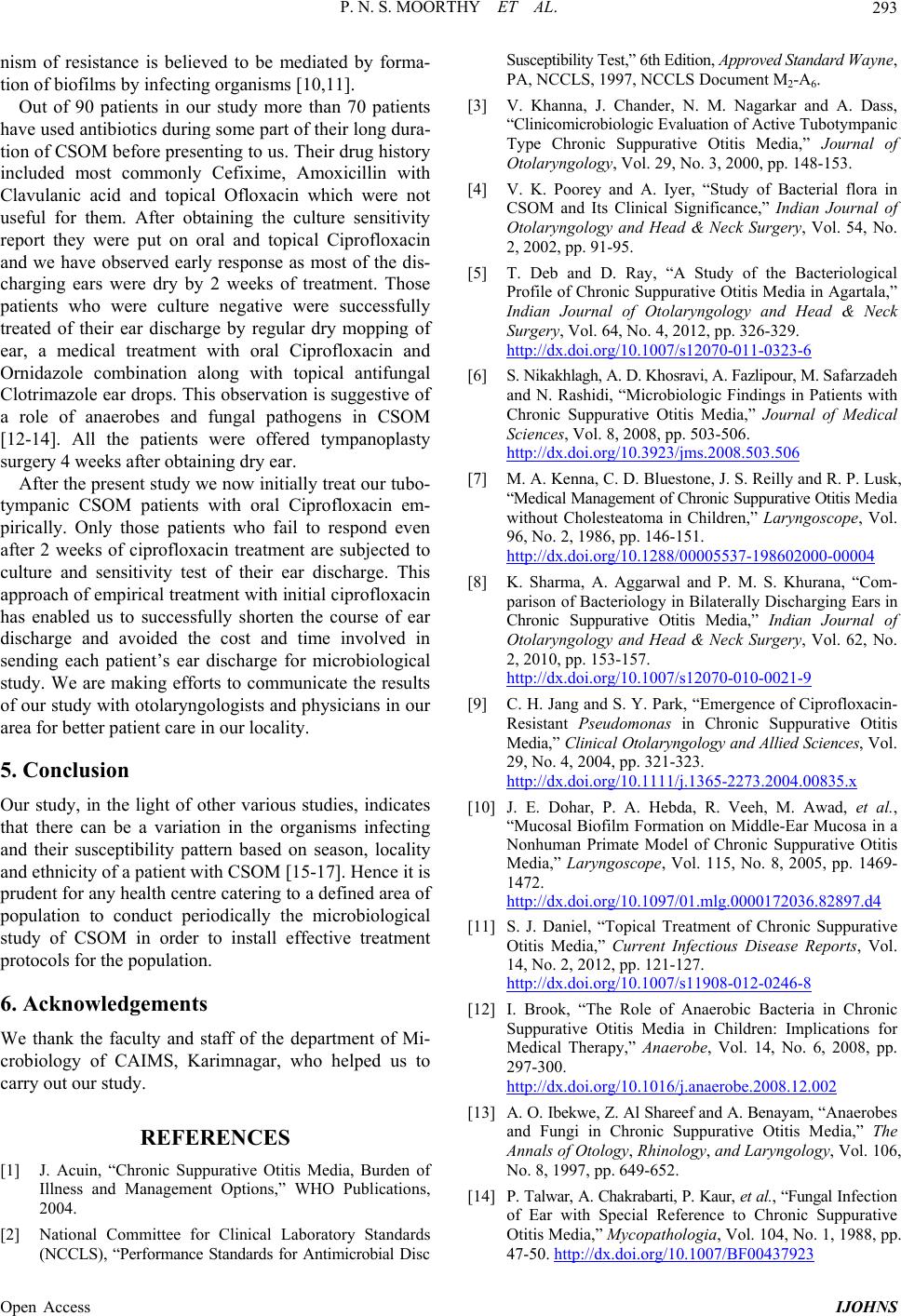
P. N. S. MOORTHY ET AL. 293
nism of resistance is believed to be mediated by forma-
tion of biofilms by infecting organisms [10,11].
Out of 90 patients in our study more than 70 patients
have used antibiotics during some part of their long dura-
tion of CSOM before presenting to us. Their drug history
included most commonly Cefixime, Amoxicillin with
Clavulanic acid and topical Ofloxacin which were not
useful for them. After obtaining the culture sensitivity
report they were put on oral and topical Ciprofloxacin
and we have observed early response as most of the dis-
charging ears were dry by 2 weeks of treatment. Those
patients who were culture negative were successfully
treated of their ear discharge by regular dry mopping of
ear, a medical treatment with oral Ciprofloxacin and
Ornidazole combination along with topical antifungal
Clotrimazole ear drops. This observation is suggestive of
a role of anaerobes and fungal pathogens in CSOM
[12-14]. All the patients were offered tympanoplasty
surgery 4 weeks after obtaining dry ear.
After the present study we now initially treat our tubo-
tympanic CSOM patients with oral Ciprofloxacin em-
pirically. Only those patients who fail to respond even
after 2 weeks of ciprofloxacin treatment are subjected to
culture and sensitivity test of their ear discharge. This
approach of empirical treatment with initial ciprof loxacin
has enabled us to successfully shorten the course of ear
discharge and avoided the cost and time involved in
sending each patient’s ear discharge for microbiological
study. We are making efforts to communicate the results
of our study with otolaryngologists and physicians in our
area for better patient care in our locality.
5. Conclusion
Our study, in the light of other various studies, indicates
that there can be a variation in the organisms infecting
and their susceptibility pattern based on season, locality
and ethnicity of a patient with CSOM [15-17]. Hence it is
prudent for any health centre catering to a defined area of
population to conduct periodically the microbiological
study of CSOM in order to install effective treatment
protocol s fo r t he po p ul at ion.
6. Acknowledgements
We thank the faculty and staff of the department of Mi-
crobiology of CAIMS, Karimnagar, who helped us to
carry out our study.
REFERENCES
[1] J. Acuin, “Chronic Suppurative Otitis Media, Burden of
Illness and Management Options,” WHO Publications,
2004.
[2] National Committee for Clinical Laboratory Standards
(NCCLS), “Performance Standards for Antimicrobial Disc
Susceptibility Test,” 6th Edition, Approved Standard Wayne,
PA, NCCLS, 1997, NCCLS Document M2-A6.
[3] V. Khanna, J. Chander, N. M. Nagarkar and A. Dass,
“Clinicomicrobiologic Evaluation of Active Tubotympanic
Type Chronic Suppurative Otitis Media,” Journal of
Otolaryngology, Vol. 29, No. 3, 2000, pp. 148-153.
[4] V. K. Poorey and A. Iyer, “Study of Bacterial flora in
CSOM and Its Clinical Significance,” Indian Journal of
Otolaryngology and Head & Neck Surgery, Vol. 54, No.
2, 2002, pp. 91-95.
[5] T. Deb and D. Ray, “A Study of the Bacteriological
Profile of Chronic Suppurative Otitis Media in Agartala,”
Indian Journal of Otolaryngology and Head & Neck
Surgery, Vol. 64, No. 4, 2012, pp. 326-329.
http://dx.doi.org/10.1007/s12070-011-0323-6
[6] S. Nikakhlagh, A. D. Khosravi, A. Fazlipou r, M. Safarzadeh
and N. Rashidi, “Microbiologic Findings in Patients with
Chronic Suppurative Otitis Media,” Journal of Medical
Sciences, Vol. 8, 2008, pp. 503-506.
http://dx.doi.org/10.3923/jms.2008.503.506
[7] M. A. Kenna, C. D. Bluestone, J. S. Reilly and R. P. Lusk,
“Medical Mana gement of Chronic Suppurative Otitis M ed i a
without Cholesteatoma in Children,” Laryngoscope, Vol.
96, No. 2, 1986, pp. 146-151.
http://dx.doi.org/10.1288/00005537-198602000-00004
[8] K. Sharma, A. Aggarwal and P. M. S. Khurana, “Com-
parison of Bacteriology in Bilaterally Discharging Ears in
Chronic Suppurative Otitis Media,” Indian Journal of
Otolaryngology and Head & Neck Surgery, Vol. 62, No.
2, 2010, pp. 153-157.
http://dx.doi.org/10.1007/s12070-010-0021-9
[9] C. H. Jang and S. Y. Park, “Emergence of Ciprofloxacin-
Resistant Pseudomonas in Chronic Suppurative Otitis
Media,” Clinical Otola ryngology and Allied Sciences, Vol .
29, No. 4, 2004, pp. 321-323.
http://dx.doi.org/10.1111/j.1365-2273.2004.00835.x
[10] J. E. Dohar, P. A. Hebda, R. Veeh, M. Awad, et al.,
“Mucosal Biofilm Formation on Middle-Ear Mucosa in a
Nonhuman Primate Model of Chronic Suppurative Otitis
Media,” Laryngoscope, Vol. 115, No. 8, 2005, pp. 1469-
1472.
http://dx.doi.org/10.1097/01.mlg.0000172036.82897.d4
[11] S. J. Daniel, “Topical Treatment of Chronic Suppurative
Otitis Media,” Current Infectious Disease Reports, Vol.
14, No. 2, 2012, pp. 121-127.
http://dx.doi.org/10.1007/s11908-012-0246-8
[12] I. Brook, “The Role of Anaerobic Bacteria in Chronic
Suppurative Otitis Media in Children: Implications for
Medical Therapy,” Anaerobe, Vol. 14, No. 6, 2008, pp.
297-300.
http://dx.doi.org/10.1016/j.anaerobe.2008.12.002
[13] A. O. Ibekwe, Z. Al Shareef and A. Benayam, “ Ana er ob es
and Fungi in Chronic Suppurative Otitis Media,” The
Annals of Otology, Rhinology, and Laryngology, Vol. 106,
No. 8, 1997, pp. 649-652.
[14] P. Talwar, A. Chakrabarti, P. Kaur, et al., “Fungal Inf e ct io n
of Ear with Special Reference to Chronic Suppurative
Otitis Media,” Mycopathologia, Vol. 104, No. 1, 1988, pp.
47-50. http://dx.doi.org/10.1007/BF00437923
Open Access IJOHNS